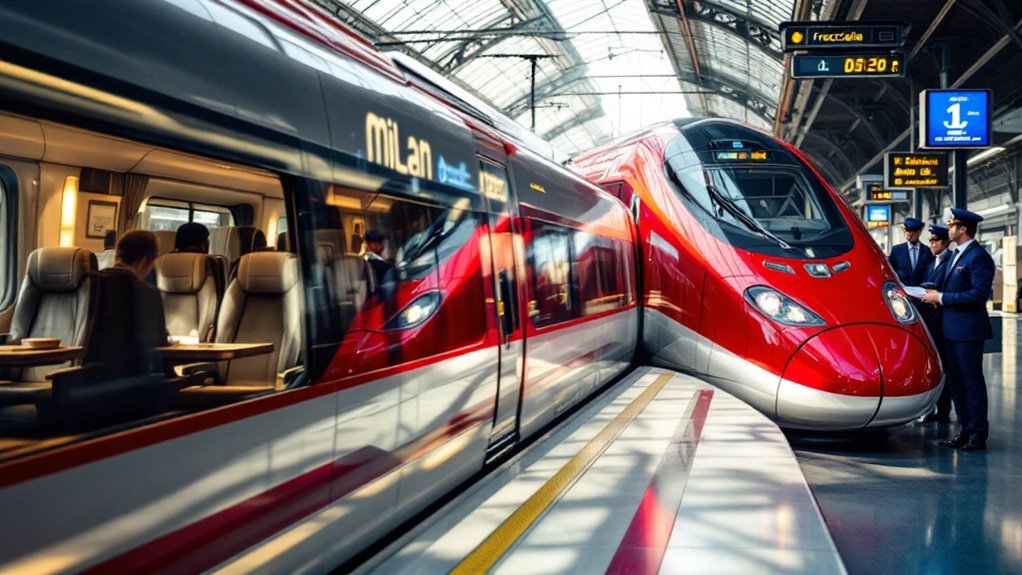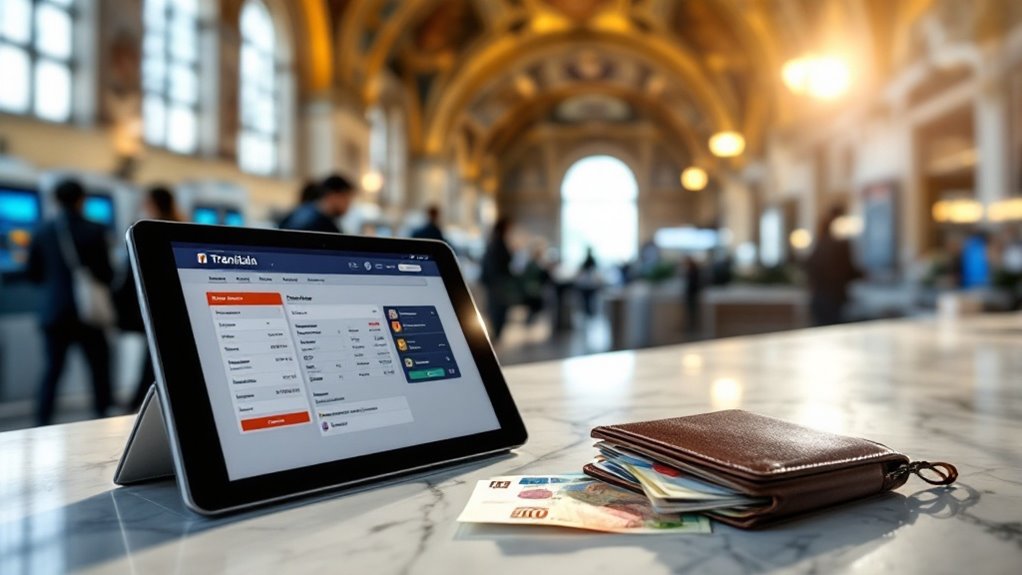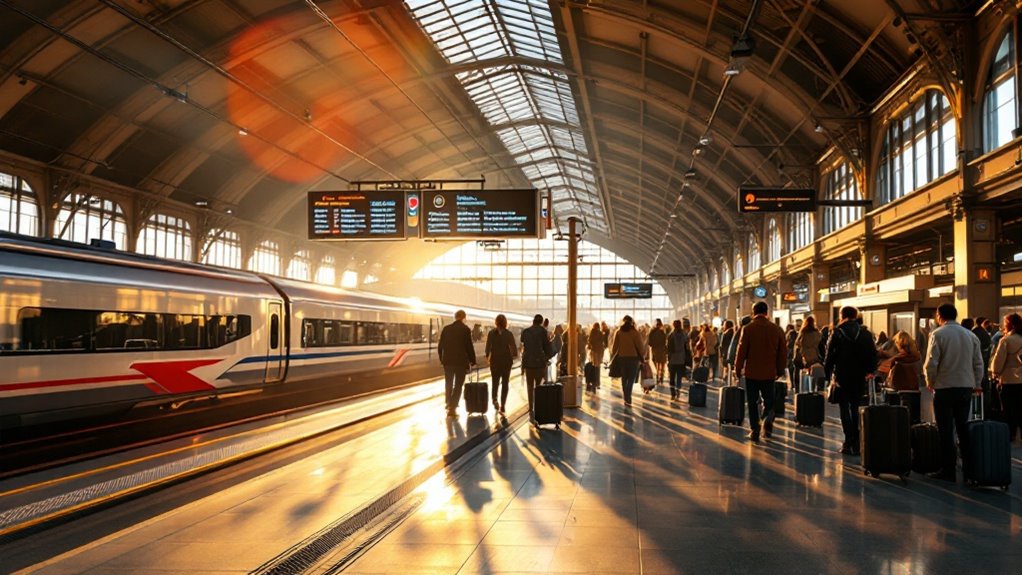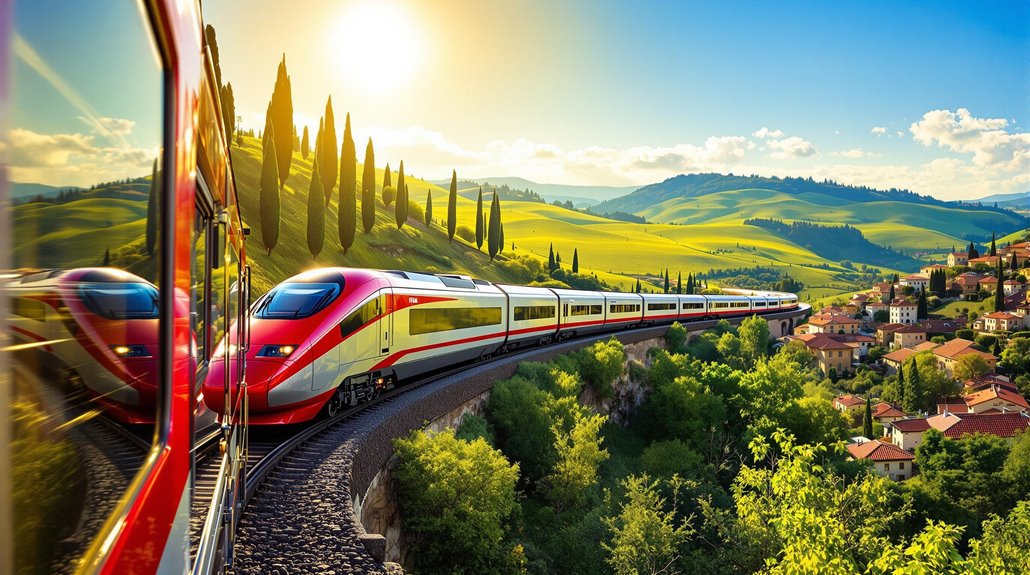Italy’s train system offers an efficient way to explore over 900 destinations through a mix of high-speed and regional services. You’ll find budget-friendly regional trains for short trips and faster Frecciarossa or Italo services for major city connections. Book directly through Trenitalia or Italo’s websites to avoid fees, and validate regional tickets before boarding. Remember to arrive 30 minutes early and check departure boards marked “Partenze.” Our extensive guide covers every aspect of mastering Italian rail travel.
Key Points
- Book high-speed trains through Trenitalia or Italo’s websites in advance for best rates and major city connections.
- Validate paper regional tickets before boarding using station machines to avoid fines, while digital tickets validate automatically.
- Arrive 30 minutes early at stations and check electronic departure boards marked “Partenze” for platform information.
- Choose regional trains for budget travel and local exploration, or high-speed services for quick travel between major cities.
- Download the Trenitalia app to track schedules in real-time and receive delay alerts during your journey.
Understanding Italy’s Train Types and Services

When planning your Italian rail journey, you’ll encounter four main types of trains: high-speed, regional, intercity, and private tourist services.
High-speed trains operated by Trenitalia (Frecciarossa, Frecciargento, and Frecciabianca) and Italo offer the fastest connections between major cities, reaching speeds up to 300 km/h. Booking early online through official websites typically results in the best fares.
Regional trains provide budget-friendly service to smaller towns but require ticket validation before boarding. They’re slower but offer significant savings compared to premium services. Arriving at least 20 minutes early before departure ensures smooth boarding and platform location.
Intercity trains strike a balance between speed and cost, including overnight options with sleeper cabins. They’re ideal for exploring authentic towns and coastal regions.
Private operators like Italo compete with Trenitalia on major routes, while specialized tourist trains access scenic and less-traveled areas, giving you unique travel experiences at varying price points.
Successfully boarding your Italian train starts with mastering the station environment. You’ll need to navigate electronic boards displaying “Partenze” (departures) and locate your train by its number rather than destination.
Most stations provide essential services, and you’ll need to arrive at least 30 minutes early to avoid rushing. Not validating your ticket before boarding could result in heavy penalty fines. Disabled travelers can access comprehensive support through the Blue Hall assistance available at major stations across Italy.
Key station features you’ll encounter:
- Electronic boards showing train numbers, destinations, and “binario” (platform) numbers
- Yellow validation machines for stamping tickets before boarding
- Left luggage facilities if you need to store bags
- Information offices and “Sala Blu” services for travelers needing special assistance
Remember to check the main departure board first, then locate your platform’s specific board for final confirmation.
Station names may appear abbreviated (like ROMA TE for Rome Termini), so familiarize yourself with these shortened versions.
Booking Train Tickets: Online and In-Person Options

Choosing the right way to book your Italian train tickets can greatly impact both your budget and travel experience.
You’ll find several reliable online platforms, including Omio, Trainline, and ItaliaRail, which charge small service fees ($1-$3) but offer user-friendly interfaces and e-tickets.
Direct booking through Trenitalia or Italo’s websites is recommended to avoid extra fees and surprises.
While Trenitalia’s official website has no booking fees, it can be problematic with non-Italian credit cards.
For in-person booking, you can use automated ticket machines at stations or visit ticket windows. Train stations offer both first-class and second-class seating options to match your comfort preferences.
However, foreign credit cards mightn’t work in machines, and window lines can be long.
Don’t worry about booking regional trains in advance – prices stay the same, and you can buy them just before traveling.
For high-speed trains, book early online to secure better rates and avoid last-minute hassles.
Essential Tips for Validating and Using Train Tickets
Understanding ticket validation rules in Italy can save you from hefty fines and travel disruptions. Since September 2024, digital regional tickets validate automatically at departure time, but it’s essential to know the specific requirements for your ticket type.
- High-speed and specific date/time tickets don’t need validation – they’re good to go at purchase
- Regional paper tickets must be stamped at station machines before boarding
- Digital regional tickets validate through the Trenitalia app or check-in link
- If your ticket says “NOT VALID TO TRAVEL,” you must check in before departure
With over 2000 train stations across Italy, you’ll find validation machines readily available at every departure point.
Remember that rail pass holders must have their passes validated twice – once at the ticket office and again at the station before their first journey.
High-Speed Routes and Popular Destinations

Two major rail companies dominate Italy’s high-speed train network: Trenitalia’s Alta Velocità (AV) and NTV’s Italo services.
You’ll find their fastest trains, like the Frecciarossa, reaching speeds up to 300 km/h, connecting major cities from Turin to Salerno.
The most popular high-speed route runs from Turin to Salerno, stopping at Milan, Bologna, Florence, Rome, and Naples. A major milestone was reached when the Milan-Bologna segment opened in December 2008, significantly reducing travel times along this corridor.
If you’re seeking scenic journeys, take the Venice to Florence line for stunning views of Tuscany, or hop on the Cinque Terre Express to explore the five coastal villages. The train departs regularly, with nearly 100 trains running daily every 15 minutes between villages.
For budget-conscious travelers, Eurail Pass holders can use these trains with an additional supplement fee and mandatory reservation.
Watch for new routes opening soon, including Turin-Venice and Milan-Genoa, which will expand your travel options considerably.
Regional Train Travel and Local Connections
While high-speed trains offer luxury and speed, Italy’s regional trains provide a more budget-friendly and thorough way to explore the country. You’ll find these trains connect smaller towns and rural areas that high-speed services don’t reach, making them essential for authentic Italian exploration. Remember to validate your ticket before boarding any regional train.
Key advantages of regional trains include:
- No reservations needed – just buy your ticket and hop on
- Fixed pricing that won’t surge during peak times
- Free seating – choose any available spot
- Ideal for day trips and visiting off-the-beaten-path destinations
When using regional trains, arrive 20-30 minutes early and check schedules carefully. You can buy tickets through the Trenitalia app, website, or station machines.
While they’re slower and make more stops, you’ll save money and see parts of Italy most travelers miss.
Money-Saving Strategies for Italian Rail Travel
To get the most value from Italy’s extensive rail network, you’ll need to master several money-saving strategies.
Book your tickets at least 14 days in advance to access ultra-cheap Speciale Frecce fares and Italo’s promotional offers, which can save you up to 70%.
Consider investing in discount cards like Carta Verde for youth or Carta d’Argento for seniors, offering year-round savings on Trenitalia trains.
For multiple short trips, the Trenitalia Pass or Italia In Tour Pass can be more economical than individual tickets.
If you’re not in a hurry, choose regional trains over intercity services – they’re often two-thirds cheaper.
Groups should look into Italo Friends Offer for discounts up to 60%, while frequent travelers can benefit from the Travel Pack Smart Worker with up to 80% savings.
What to Expect During Your Train Journey
Before stepping onto an Italian train, you’ll need to navigate several essential pre-boarding procedures. Arrive 20-30 minutes early to validate your ticket at the yellow machines on the platform and check the electronic boards for your train’s information.
Once aboard, you’ll experience different amenities based on your ticket class:
- First-class cars offer wider seats, power outlets, and complimentary snacks on high-speed trains
- Regional trains make frequent stops while high-speed services focus on major cities
- Many routes feature panoramic windows for scenic countryside views
- Restaurant cars and snack services are available on longer journeys
Upon arrival, be ready to gather your belongings quickly.
Most stations are centrally located with convenient access to city centers, and you’ll find helpful facilities like luggage storage and tourist information desks.
Planning Multi-City Train Adventures
Since Italy’s extensive rail network connects virtually every major city, planning a multi-city train adventure offers both flexibility and cost savings.
Start by mapping your route through major hubs like Roma Termini, Milano Centrale, or Firenze Santa Maria Novella, then book high-speed Freccia trains for longer distances and regional trains for shorter segments.
Book your high-speed tickets well in advance through Trenitalia or Italo’s websites to secure the best deals.
If you’re planning multiple train journeys, consider a Eurail Italy Pass for potential savings.
For regional trains connecting smaller towns, you don’t need advance bookings.
Download the Trenitalia app to track schedules and get delay alerts in real-time.
Remember that seat reservations are mandatory on high-speed trains but not on regional services.
Safety and Security on Italian Trains
While Italian trains maintain a strong safety record, understanding key security measures can enhance your travel experience. Major stations like Roma Termini and Milano Centrale have implemented extensive security systems, including access gates and surveillance cameras.
- Keep your validated ticket handy – you’ll need it to pass through security checkpoints.
- Stay alert in stations and on trains, especially during late hours.
- Store valuables securely and maintain awareness of your surroundings.
- Use authorized taxis or ride-shares when leaving stations in unfamiliar areas.
Train conductors now carry body cameras and have direct access to Railway Police, adding an extra layer of security.
When planning your journey, research your arrival station’s location and surrounding area in advance. Most stations feature restricted lounges for ticketed passengers, offering a secure waiting area before departure.
The Last Word
You’ll save a mountain of money and countless hours by mastering Italy’s train system. With blazing-fast routes connecting every major city for a fraction of flying costs, you’re crazy not to hop aboard. Don’t waste another second – grab your ticket, validate it, and join millions of smart travelers who’ve discovered Italy’s best-kept secret: its incredible rail network. It’s the ultimate budget-savvy way to experience la dolce vita.

